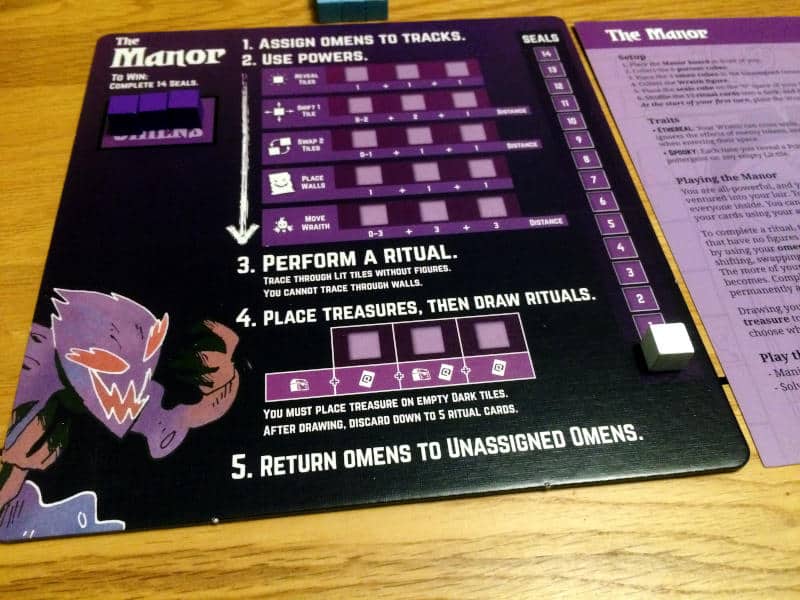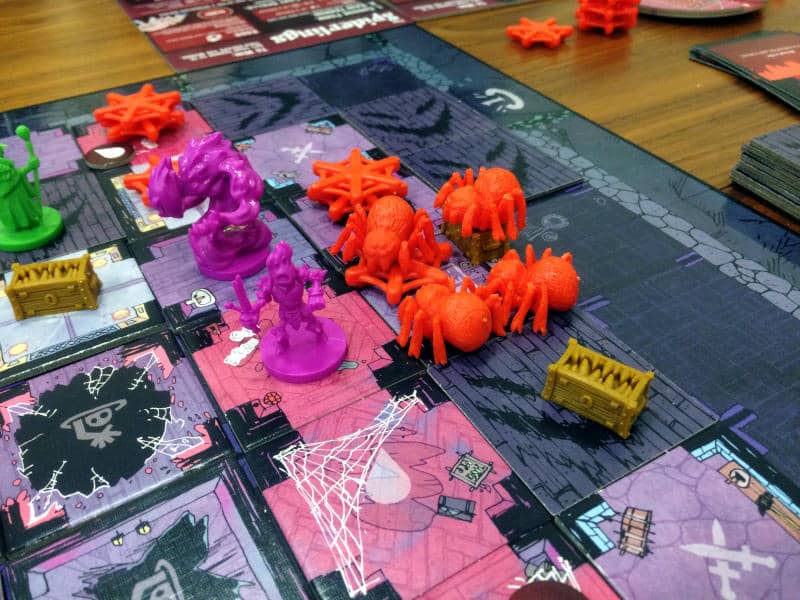| Release Date: 2019 | Players: 1-5 |
| Designer: Patrick Leder | Length: 60-120 minutes |
| Artist: Kyle Ferrin | Age: 12+ |
| Publisher: Leder Games | Complexity: 3.0 / 5 |
| Plastic (by weight): unknown | Air (by volume): unknown |
It was time to prove myself as a favoured crusader once again. My goal was to kill the devious Spider, while being very careful to avoid the Skeletons. Both of these enemies were out to kill me. I had my Fury and my Light, representing my devotion to my divine goals and I knew I could use these to powerful effect. Ultimately though, it was Grit that would increase my capabilities as a hero. I took a deep breath and then entered Vast: The Mysterious Manor by Patrick Leder from Leder Games.
Here is another great asynchronous game from the publisher that is possibly better known for Root and Oath. However, while all three of these games feature factions with different abilities or goals and all three were illustrated by the amazingly talented Kyle Ferrin, the designer isn’t the same for all of them. Vast: The Mysterious Manor was designed by Patrick Leder and Root and Oath by Cole Wehrle. However, you still feel that there are links and similarities between all three games. Vast and Root share similar mechanisms, while Oath tried to build on the gameplay experience of Vast. So, in a way, Vast is the forerunner to both Root and Oath.
Shared Asymmetries
If you have played Root, then Vast: The Mysterious Manor will feel very familiar and vice versa. You have a shared game board, the Mysterious Manor in the case of Vast, and a number of different characters: the Paladin, the Spider, which can change its form, the Skeletons and, of course, the Manor itself. Oh, I nearly forgot the Warlock, which kind of feeds off the spectres that the Manor creates. All characters play in very different ways and they all have completely different winning conditions. That’s very much what you have in Root too, of course.
However, while the factions in Root all interact with each other, in Vast there is more of a food chain. The Skeletons’ aim is to kill the Paladin, who tries to kill the Spider, which just drinks blood and tries to create a lot of terror. The Manor, in the meantime, does its own thing and basically just tries to clear the corridors so it can complete rituals. The Warlock also does its own thing and benefits from the Manor’s shenanigans and other players. The characters’ interaction means that which characters are in play will depend on the player count. The rulebook suggests specific combinations for two, three and four players. It’s only when you have five players that all characters are in use.
So the choice of who gets to play what is slightly limited and set-up adjustments are sometimes required if you don’t play with the full complement of characters in play. That’s not a real problem though, because there are still plenty of choices. It’s also not too dissimilar to Root‘s suggested selection of characters in play for certain player counts.
Learning Vast: The Mysterious Manor
Learning the game isn’t actually too hard. There are some common actions and concepts that apply to everyone. These are pretty easy to teach. After that, everyone just needs to read their player board and player sheet that give additional information and explain the character’s unique actions and abilities, as well as how to set it up and how to win. The sheet also explains how the character interacts with others and gives some very rough strategy advice, which I think is really helpful.
Once everyone has set up their character and read their player sheet, the game is ready to be played. I actually recommend you start playing and learn as you go. I found movement to be probably the weirdest action. The manor is mostly unexplored at the beginning of the game. As you move around, you add room tiles to the board. However, these rooms are dark to begin with, so you don’t know what’s in them. You have to spend an action to light them up and flip them over.

Other than that, you have to just make sure you understand your actions correctly and refer back to the rulebook when necessary. You also have to trust everyone else around the table to play their characters correctly. It would take too much time for everyone to fully understand everyone else’s abilities and actions. That’s again very similar to Root.
I encourage that players talk through their turns out loud, so everyone else can get a feel for what it is that you’re doing. It really helps and is also a prompt for people to double-check their character’s rules.
Stop the Leader
As you can imagine, having different characters work on the same board, but all trying to achieve different goals, creates a really interesting gameplay experience. The Manor, for example, sort of works together with the Paladin, because they need the rooms to be lit up and the Paladin is in the best position to do that. So the Manor will try and help the Paladin, but only up to a point. After all, if the Paladin wins, everyone else loses, including the Manor.
It’s the usual situation where you try and help other players, but not too much. I think it’s all fair and square to publicly negotiate with other players and discuss with them your next move. If you offer to take actions in such a way that helps another character, then they may want to help you as well. Nothing is binding in Vast: The Mysterious Manor and you can’t actually trade anything, but it’s still important to talk to other players.
After all, at some point in the game, there will be one or even two players who are close to winning. It’s then in the interest of everyone else to stop the leader. Some characters can’t really do anything to physically prevent someone from winning, like the Manor, but they might be able to set up other players to do so. That’s where Vast feels very much like Oath. The Manor might be able to teleport the Paladin closer to the Spider, so that they can kill them, for example. However, if the Spider dies, the Paladin wins. So the Manor has to decide how much to help.
All Manor of Decisions
The game starts relatively slowly, at least for some characters. Others do hit the ground running, but then slow down later on. As more rooms are explored and people get to really ramp up the power of their characters, the game suddenly changes. Victory is often only one turn away. That’s when the table talk really kicks in and everyone tries to work out how to squeeze out one more round. It’s the end game that is so hugely exciting in Vast: The Mysterious Manor. If one player can stop the winner, while also preventing another player to take victory, then maybe, just maybe, the game will continue for a little bit longer.

Emotions tend to run high. The person who is so close to winning will sit there with bated breath to hear what the other players are planning. They will watch in dismay when their victory is snatched away from them – or there will be a huge sigh of relief when they can still wrangle the win they feel they rightfully deserve. In the meantime, everyone else frantically discusses different options to allow the game to continue. Nobody wants to reveal too much information and nobody wants to offer too much help, because everyone wants to take first place for themselves.
It’s just amazing and right up there with the experience you get in Oath near the end. If player A stops player C from winning, then player D might get a shot, which means player B needs to stop player D – but then player A might be able to win instead. It’s a lot of “if this, then that”.
Vast or Root or Oath
I don’t really want to have to compare all three games. They are similar in some ways, but also very different. I will always be very happy to play Vast: The Mysterious Manor, even though I do feel it’s a bit harder to learn than Root. Also, there is much more negotiating and table talk in Oath than there is in Vast. So ultimately, if I had to choose between Vast and Root, I’d choose the latter – and the same goes for Vast vs Oath.
I suppose it’s an unfair comparison really. It’s clear that many ideas from Vast were used to develop Root and Oath into the more refined games they are. They have a lot more depth and the game experience is smoother and cleaner. Well, I do have to admit that Oath is a bit of a beast, but it still represents an amazing storytelling game. Root, on the other hand, is the better game when you want to play with different factions doing different things on a shared board.
However, if you didn’t get on with Root or Oath, then I definitely recommend you give Vast: The Mysterious Manner a go. It’s a hugely enjoyable game and definitely deserves to be played and enjoyed by a lot of people.
Keeping the blog running takes time and resources. So if you can chip in, that would be amazing.
Useful Links
- Vast: The Mysterious Manor: https://ledergames.
com/ collections/ full-catalog/ products/ vast-the-mysterious-manor - Leder Games: https://ledergames.
com/ - Rulebook: https://cdn.
shopify. com/ s/ files/ 1/ 0106/ 0162/ 7706/ files/ TMM_ Rulebook_ _ Nov_ 6_ 2019. pdf? v= 1594699333 - BGG listing: https://boardgamegeek.
com/ boardgame/ 252399/ vast-mysterious-manor - Root review: https://tabletopgamesblog.
com/ 2022/ 02/ 12/ root-a-game-of-woodland-might-and-right-saturday-review/ - Oath review: https://tabletopgamesblog.
com/ 2021/ 11/ 27/ oath-chronicles-of-empire-and-exile-saturday-review/
Transparency Facts
I feel that this review reflects my own, independent and honest opinion, but the facts below allow you to decide whether you think that I was influenced in any way. Please also read my Ethics Statement for more information.- I played a friend's copy of the game.
- At the time of writing, I have not received financial support from the publisher or anyone working on their behalf.
Audio Version
Intro Music: Bomber (Sting) by Riot (https://www.
The following music was used for this media project:
Music: Bugbears Be Approaching by Tim Kulig
Free download: https://filmmusic.io/song/8518-bugbears-be-approaching
License (CC BY 4.0): https://filmmusic.io/standard-license






